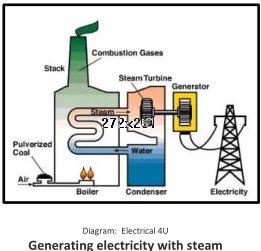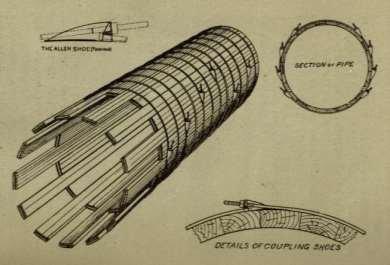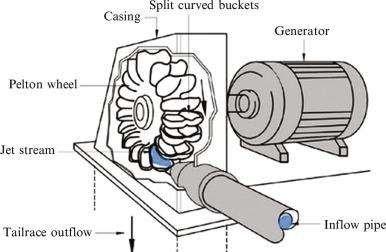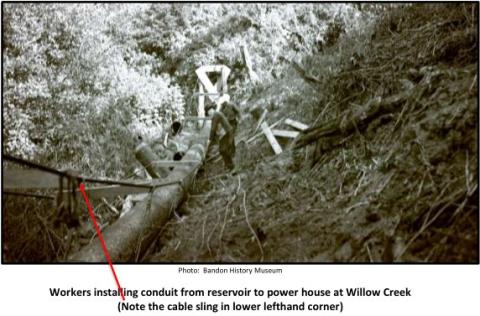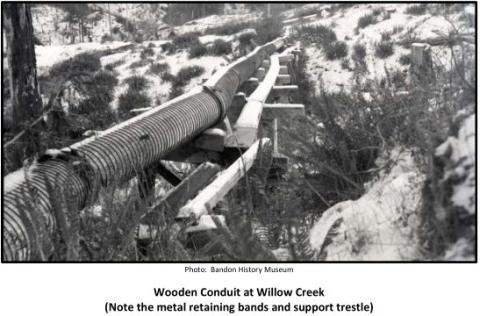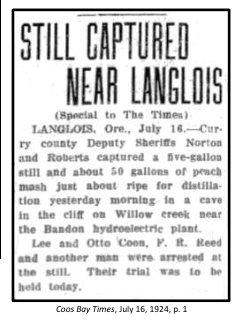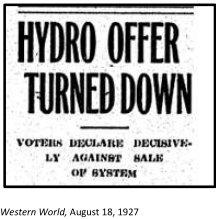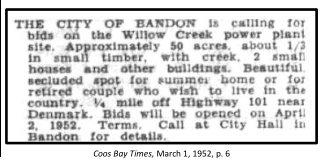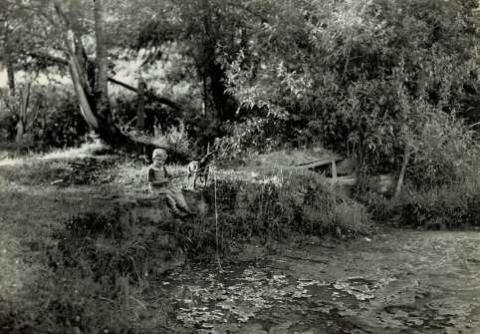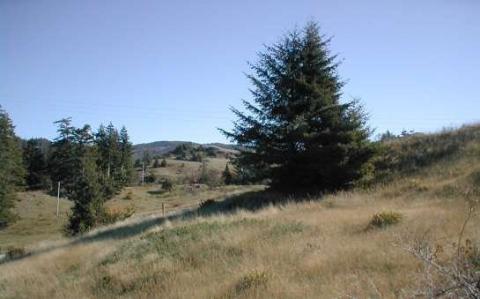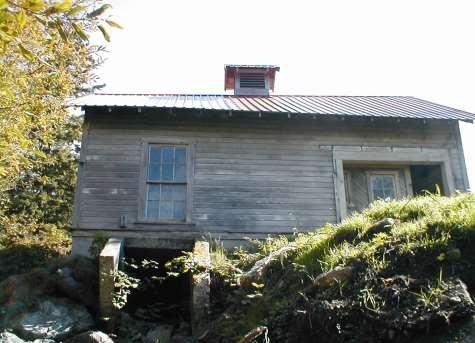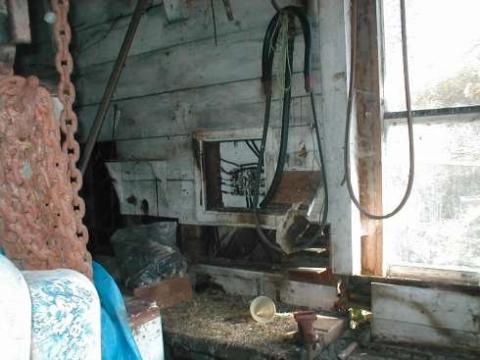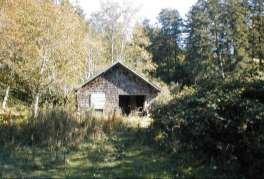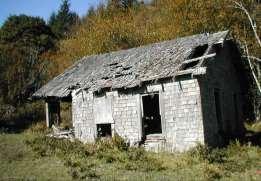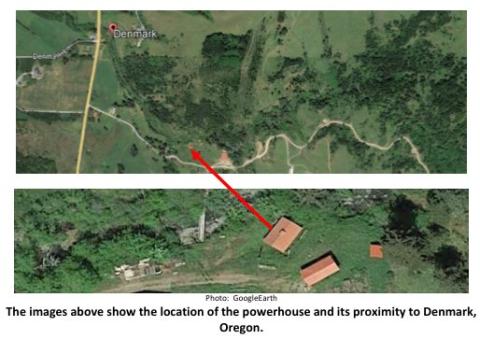By Jerrry and Bonnie Cox
Langlois (that gateway to Denmark, Oregon) once relied on the little hamlet for its electric power. Denmark was settled during the late 1800's and early 1900's, primarily by farmers and ranchers with Scandinavian heritage. It was once a bustling community of several hundred people and had a cheese factory, post office, a general store, dance hall, and school. A person could take music lessons from Jennie Malehorn, employ J. H. Upton for notary and collection services, and have fresh meat delivered by Joseph Hare. The townlet even had its own newspaper, the Southwest Oregon Recorder. With Willow Creek being the area’s primary geographical feature, dozens of homesteads were established in the surrounding area.
In the early 1900s the nation was gradually becoming “electrified”. Locally, Marshfield and North Bend were the first to utilize the new source of power on a wide-scale; Coquille and Myrtle Point soon followed. At the time, the most common way to produce electricity was to use a generator driven by a spinning turbine. However, in order to make the turbine turn, another source of power was needed. Steam was the power source of the day and the fuel for producing it was either coal or wood. As shown in the diagram below, coal or wood heated the water, creating steam. The steam then turned the blades on a rotor shaft that in turn spun the generator, thereby converting kinetic energy into electrical energy. Although that method was successful, it did require a continuous source of coal or wood and was labor intensive. .
|
|
A more efficient process was to turn a turbine by using the force of water. Bandon had its own steam-generated electric plant in 1907, but it was in need of a method that would produce more horsepower to meet the needs of the city's growing population and industrial expansion. In the early 1920's, Bandon’s city council decided to explore the possibility of converting to hydroelectric power, but for that they needed to find an appropriate water source. A firm was hired to do a feasibility study to determine if such an idea was viable and practical. One by one, rivers and streams in the area were examined and then dismissed because there was either not sufficient water flow or there was not enough drop in elevation to create the force needed to drive a turbine. Four Mile Creek, Floras Creek, Crystal Creek, Sixes River, and Elk River all came up short. But one water source seemed ideal, and that was Willow Creek at Denmark, Oregon.
Plans were developed. Engineers calculated that establishing a hydroelectric facility on Willow Creek would necessitate constructing a 120-foot-long diversion dam of logs, rock, and earth, sixty feet high and sixty feet thick at the base. A portion of Willow Creek would need to be diverted into a reservoir that would hold forty acre-feet of water (Bandon Western World, February 24, 1921, p. 1). One acre-foot contains 336,000 gallons of water. A forty-acre-foot reservoir would equate to forty feet of water covering an area of one acre. One acre is about the size of 1.3 football fields. The dam would have to be located more than a mile upstream from a proposed powerhouse to ensure there would be the necessary water velocity to generate electricity. A powerhouse and other buildings would have to be built close to the Roosevelt Highway (later HWY 101). Large cedar stave conduits, reinforced with metal Allen shoe retaining bands and coated with tar needed to be installed to transport the water from the reservoir part of the way to the power station. The wooden conduits would then gradually be reduced in diameter with iron pipes to increase the force of the water. Ditches, tunnels, timber trestles, and cable slings were needed in some areas to allow proper footing for the heavy arterials.
|
|
Inside the powerhouse there would be a large steel turbine known as a “Pelton wheel” attached to a shaft connected to a generator (diagram below.) The torrent of Willow Creek water entering the powerhouse via the inflow pipe would be directed toward the buckets on the Pelton wheel, causing it to turn rapidly. As it turned, it transferred its energy to spin a generator that in turn would create an electric current. There was also a Plan B should water levels drop: Divert Crystal Creek north of Sixes into Willow Creek, a notion that was extremely impractical due to elevation discrepancies.
A work camp had to be established on the John Chenoweth homestead for the 40-50 workers that would be needed to complete the project. Tents for a field mess hall, sleeping quarters, and even a “Men’s Area” were all part of the plan to facilitate the work effort as the construction crew would have to stay on the premises to maximize efficiency.
Engineers estimated that a maximum of 400 horsepower could be created using the planned method. The existing Bandon power plant was capable of producing a maximum of only forty horsepower (Ibid). Transmission lines from Denmark to Bandon would need be erected and rights-of- way secured.
All of this would come at a cost: (Beckham, Dow, Bandon-By-the-Sea, 1986. Pgs. 92-93)
Construction of dam $25,283
Pipeline $26,874
Powerhouse & Machinery $ 7,479
Transmission Lines and rights-of way $25,538
In March, 1921, the City of Bandon floated a $110,000 bond ($2 million in 2024 dollars) to cover the Willow Creek hydro project and purchase of equipment from the old Bandon Power Company. The bond measure was overwhelmingly approved by Bandon voters. Hydroelectricity at Willow Creek would become a reality (Coos Bay Times, March 9, 1921, p. 1). The bond was purchased by a company in Portland, Oregon and work on the project commenced almost immediately.
|
|
In early January, 1921, the Willow Creek Hydroelectric Power Plant was ready for its first test run. There had been cost overruns and the dam proved more difficult to construct than anticipated, but the project was complete. The trial test was limited to slowly releasing the reservoir water so that it could activate the Pelton wheel which in turn put the generator in motion. The goal was simply to light the powerhouse. It worked! There were still obstacles to overcome, but the end was in sight. An earthquake one month later separated some of the wooden pipes, but they were soon repaired. In August, 1922, Bandon began receiving electricity generated by the Willow Creek Hydroelectric Power Plant located at Denmark. By the end of the year, Langlois and points north of Willow Creek also reaped the benefits of the new power source. But ironically, homes and farms south of Willow Creek would not receive electricity until 1932. All power generated by Willow Creek traveled north.
Within a few short years there was competition in the electrical power market. Mountain States Power Company offered to install a diesel-fueled generator at Beaver Hill (approximately 12 miles south of Marshfield) and supply electricity to Bandon. Bandon administrators felt they needed a backup to the Willow Creek facility and signed a contract with Mountain States. At the same time, they also invested in newer and more efficient machinery for the Willow Creek plant. To help offset costs, employment at the hydro facility was reduced (Ibid, October 29, 1924, p. 2). Although only two years old, competition and expense proved to be early harbingers that would determine the longevity of the Willow Creek Hydroelectric Power Plant.
In July, 1924, a different type of "juice" was being generated near the power plant.
|
|
| In mid-1924, it became apparent to some that maintaining a hydroelectric plant miles away from where the product was destined may not be the most cost effective way of providing power to Bandon. Mountain States Power Company was eager to provide full service that would allow Bandon to cease operating and maintaining the Willow Creek dam, pipeline, and powerhouse. Mother Nature also played a role in the sentiment as storms and lightning frequently played havoc with the service. |
It came as no huge surprise that in May, 1927, the Bandon City Council recommended that the hydro plant at Willow Creek be sold. It was a contentious issue. The city council even put a price of $120,000 on the sale, but it would require voter approval. The voters convincingly turned down the measure.
A company in Oklahoma and another in Northern California made offers in 1928 and 1929 to buy the hydro plan, but their offers fell on deaf ears. In fact, in 1932, Bandon updated the Western World, August 18, 1927 Willow Creek facility and installed a new circuit panel and gauges, expanded the capacity of some transmission lines, and made plans to extend power south as far as Port Orford (Ibid, May 11, 1932, p. 5).
On September 26, 1936, much of Bandon was decimated by fire. Transmission lines from Willow Creek to Bandon were destroyed in some areas, but the power plant itself was not damaged. Much of the economy of Bandon was ruined, homes demolished, and people displaced. The following year, Port Orford established its own diesel power plant, thus relying less on the electricity provided from Willow Creek. Both events challenged the continued existence of the dam and powerhouse at Denmark.
In 1935, President Roosevelt created the Rural Electric Administration (REA) to provide electricity to rural area. Soon electrical cooperatives (co-ops) sprung up around the state.
In 1938, the Bonneville Dam on the Columbia River was finished and it would play a major role in determining how electricity was to be distributed in the Pacific Northwest. Bandon soon began to investigate the advantages of securing electricity from the Bonneville Power Administration (BPA). Cities throughout Oregon were signing contracts with the BPA, for not only was the new source of power reliable and relatively inexpensive, it relieved local governments of having to operate and maintain their own power plants.
The Coos Electric Co-op was established in 1940 and extended lines into Curry County serving areas that were not supplied with power from Willow Creek. Coos Electric Co-op bought the Port Orford power plant and the continuation of the Willow Creek Hydroelectric Power Plant was again threatened. And then came war.
During 1941-1945, attention and resources were directed toward the war effort. It was a time of resurgence for the power emanating from Willow Creek as the farms in the Floras Lake area were deemed essential for producing food, yet they had not yet been electrified. The Office of War directed that power be furnished and farms owned by Charles and Allie Farrier, Art Strain, Chas. Fox, and Frank Kenworthy were soon "on-line." Interestingly, the Floras Lake Hotel was not included in the program even though it was serving as home base for the U.S. Coast Guard and its Shore Patrol. The War Department reasoned that since the facility already had a Kohler diesel generator it did not need to be connected to the grid (Western World, December 2, 1940, p. 1).
|
|
For the duration of WWII, there was somewhat of a status-quo mindset regarding the Willow Creek Hydroelectric Power Plant.
In January, 1945, Coos Electric Co-op announced that after the war was concluded it would serve both Coos and Curry Counties. It was an ominous proclamation for the Denmark power source. In February, 1946, Coos Electric Co-op offered to purchase the Willow Creek Hydroelectric Power Plant and all transmission lines for $65,000. The City of Bandon countered with $75,000 and the adjusted price was agreed upon. But voters still had to approve the sale. In May, 1941, by an eleven-vote margin, the voters of Bandon rejected the transaction. Soon after, Coos Electric Co-op was renamed Coos-Curry Electric Co-op.
|
|
In November, 1946, Bandon City Utility Manager A. E. Pitts stated, "A larger budget and securing unavailable materials are two items most desperately needed to relieve our capacity loaded hydro-electric system." (Ibid, November 14, 1946, p. 1). Three months later it was announced that the BPA had entered into a contract with Mountain States Power Company which in turn would sell power to Bandon in the future. It was a death knell for the Willow Creek Hydroelectric Power Plant, but it continued to operate for a few more years.
An engineering firm was retained by the City of Bandon to do a feasibility study regarding the dam and powerhouse in 1949. The recommendation was that the city should abandon the Willow Creek power plant as soon as BPA power was made directly available because the facility simply could not produce power as cheaply as the BPA (Ibid, May 19, 1949, p. 1). The Denmark turbine continued to spin for another year or so under the supervision of Alta Roberts (1950 Census for Langlois, Oregon), but in January, 1951, the Bonneville Power Administration negotiated control of the electrical supply of power for Bandon and Langlois, and the generator on Willow Creek came to a final halt.
|
|
There were three bids for the property and Edwin “Bud” Bement's was the highest at $3,600 (Ibid, April 10, 1952, p. 1). Bement already owned property adjacent to the land being sold.
The dam soon fell in disrepair and its reservoir slowly receded back into the flow of Willow Creek. Pipes and machinery were salvaged. The powerhouse and other buildings became hostages to the elements. With windows broken, doors removed from their hinges, and leaks in the roof, the powerhouse became home to critters and varmints of all types. In the late 1990's or early 2000's metal roofing was placed on the structures and some of the original plant still stands today, vestiges of a time when securing vital electric power was in its infant stages and people would go to great lengths to obtain it.
In the years that followed, the only evidence of the once expansive power system were a few abandoned buildings and a residual pond that became a fishing hole for nearby children.
|
|
The powerhouse was located to the far lower left, out of photo range, and the dam was constructed beyond the first prominent hill in center background
|
|
The Willow Creek powerhouse. Water discharged from the turbine exited through the concrete shoot on the left, and was returned to Willow Creek.
|
|
|
|
In 1981, an attempt was made by Ellis Foster to rebuild the dam and create electrical power that could be sold to the BPA. He envisioned a 95-foot-high dam, a mile of 30-inch pipeline, and a reservoir of up to 900 acre-feet. The cost was estimated between $3 million and $6 million (The World, February 13, 1981, p. 12). Permits, cost, and other circumstances kept the project from ever being fulfilled.


